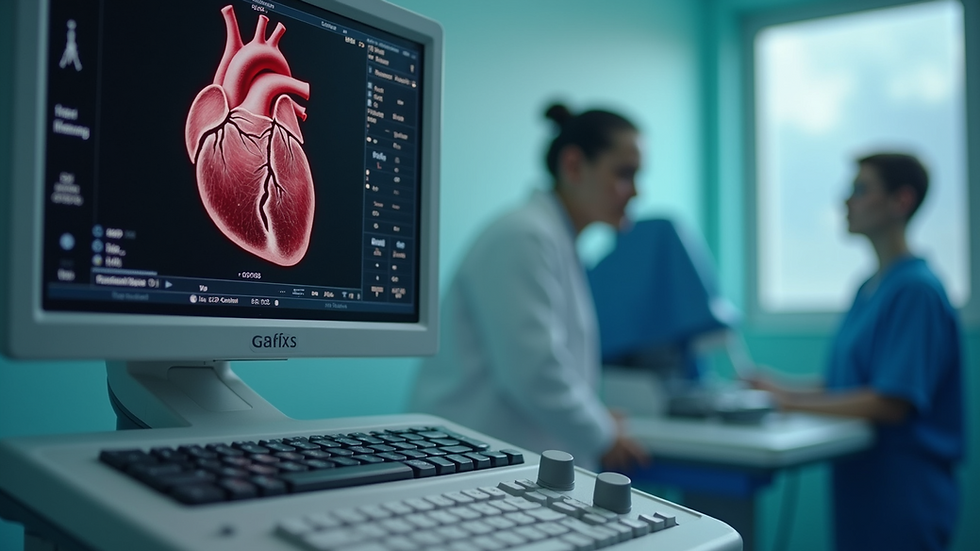Unveiling the Critical Role of Echocardiography in Today’s Medical Landscape
- Shane Yole
- Aug 13
- 3 min read
Echocardiography, a non-invasive imaging technique, is vital in modern medicine. This advanced method uses ultrasound waves to produce detailed images of the heart's structure and function. With cardiovascular diseases responsible for about 32% of global deaths, the role of echocardiography in diagnosis and treatment is more essential than ever. In this article, we will examine how echocardiography is applied in healthcare, its numerous benefits, and what the future holds for this technology.
Understanding Echocardiography
Echocardiography is a diagnostic tool that uses high-frequency sound waves to generate images of the heart. These images reveal crucial information, including the heart's size, shape, and motion, as well as the function of its chambers and valves. Key types of echocardiography are:
Transthoracic Echocardiography (TTE): This is the most common type, where ultrasound images are taken from the chest. It is widely used in routine assessments and emergency settings.
Transesophageal Echocardiography (TEE): This method uses a probe inserted down the esophagus, providing clearer images of the heart's structures. It is particularly useful for diagnosing complex cases.
Stress Echocardiography: This variation assesses heart function under stress, often induced by exercise or medication, helping to identify coronary artery disease.
The versatility of echocardiography makes it suitable for various clinical contexts, from routine check-ups to emergency interventions. It delivers real-time data about heart performance, enabling timely medical responses that can significantly improve patient outcomes.

The Role of Echocardiography in Diagnosing Heart Conditions
Echocardiography is crucial in diagnosing several heart conditions, including:
Heart Valve Disorders: It can identify conditions like aortic stenosis, which affects nearly 2% of people over age 70. Early detection of valve issues can prevent life-threatening complications.
Cardiomyopathies: This imaging technique is essential for diagnosing hypertrophic cardiomyopathy, a condition found in about 1 in 500 individuals, which can lead to heart failure.
Congenital Heart Defects: Echocardiography is vital for spotting heart defects present at birth. For instance, it can reveal ventricular septal defects in about 30% of children with heart conditions.
Heart Failure: By evaluating the heart's pumping efficiency and identifying fluid buildup, echocardiography supports heart failure diagnosis, which affects approximately 6.2 million adults in the United States.
This imaging capability allows doctors to make informed decisions about treatment, whether that involves medication or surgical options.
Benefits of Echocardiography
Echocardiography offers several advantages beyond its diagnostic capabilities:
Non-Invasiveness: Unlike more invasive procedures like cardiac catheterization, echocardiography poses minimal risks to patients, making it suitable for a wider range of individuals.
Accessibility: This test is readily available in hospitals and outpatient clinics, ensuring that patients receive timely evaluations regardless of their location.
Cost-Effectiveness: Echocardiography is more affordable than many other imaging techniques, allowing healthcare systems to provide necessary care without incurring high costs.
Real-Time Imaging: The ability to see dynamic images allows doctors to assess heart functionality rapidly, which is particularly important in emergency scenarios.
These benefits make echocardiography a cornerstone in clinical practice, leading to enhanced patient care and better health outcomes.
Echocardiography in Preventive Medicine
Echocardiography also has a significant role in preventative medicine. Regular echocardiographic evaluations can identify risks for cardiovascular diseases early. For example, patients with a family history of heart conditions or symptoms like shortness of breath should consider routine echocardiographic assessments.
Detecting issues early allows healthcare providers to recommend lifestyle changes, such as:
Increasing physical activity or improving diet
Managing blood pressure or cholesterol levels with medication
Such early interventions can drastically reduce the risk of developing severe heart issues and improve overall health.
The Future of Echocardiography
The future of echocardiography is bright, driven by technological advancements:
3D Echocardiography: This technique offers more detailed views of the heart, which can enhance diagnostic accuracy and aid in planning treatments.
Portable Ultrasound Devices: These compact devices enable echocardiography assessments in various settings, including rural areas. Their use has the potential to improve outcomes significantly by speeding up diagnosis and treatment.
Additionally, the incorporation of artificial intelligence (AI) in echocardiography promises to refine image analysis. AI can reduce the time required for interpretation while increasing diagnostic reliability, potentially transforming how healthcare providers utilize echocardiography in practice.
Final Thoughts
Echocardiography stands as a fundamental aspect of modern medicine, offering vital insights into the heart’s structure and function. Its non-invasive nature, wide availability, and cost-effectiveness solidify its importance in diagnosing and treating cardiovascular diseases. As technology progresses, echocardiography will continue to adapt and improve, enhancing patient care and supporting preventative strategies.
In a world grappling with the impact of heart disease, understanding and utilizing echocardiography can empower healthcare providers to offer better care, ultimately saving lives.











Comments